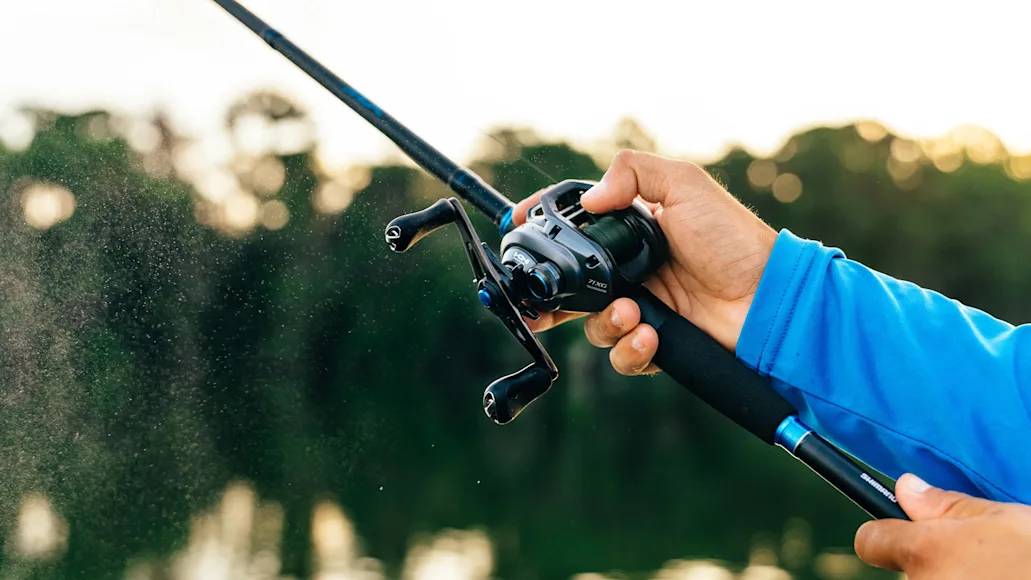We may earn revenue from the products available on this page and participate in affiliate programs. Learn more ›
Learning how to cast a baitcaster is a great way to level up your skill set and access a whole other realm of presentations, especially for bass fishing but for plenty of other applications as well. Although you can do a lot with spinning gear, there are just some baits, like big spinnerbaits, buzzbaits, jigs, chatterbaits, and frogs, that are better suited for a beefier baitcasting reel.
The only problem is that baitcasters can be a little intimidating for beginners. While the best spinning reels are user friendly for beginners, baitcasting reels come with the ever-present threat of a horrible backlash on any given cast. But if you want to broaden your capabilities, knowing how to cast a baitcaster doesn’t have to be scary. Here’s how to do it.
Table of Contents
Getting Started
Parts of a Baitcasting Reel
How to Make Your First Casts
How to Tune a Baitcaster for Perfect Casting
How To Set the Brake
How to Set the Spool Tension
How to Make Perfect Casts With a Baitcaster
Mastering Thumb Pressure
Parts of a Baitcasting Reel
We’ll keep this simple at first and go into more detail below. For now, you just need to know where to find the key adjustment knobs on a baitcaster, so here is a quick visual guide.
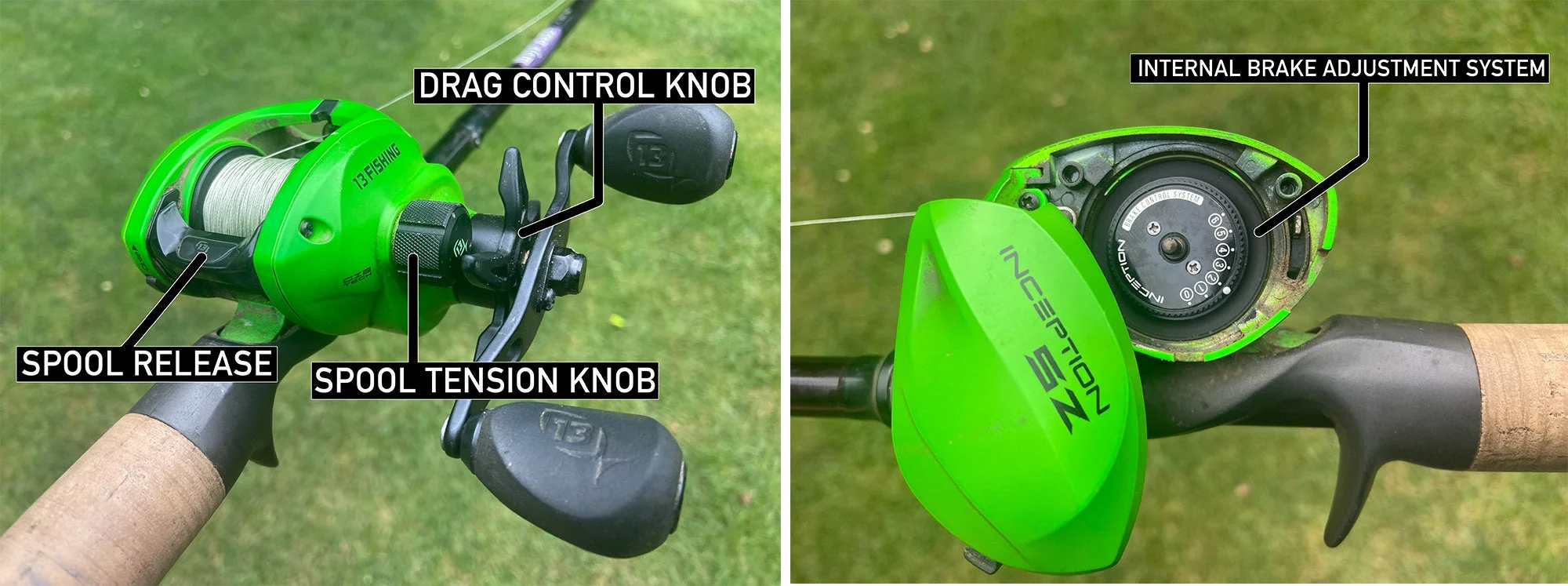
How to Make Your First Casts
Okay, now that you’ve got that, let’s assume you have a new baitcasting reel all spooled up on a rod and you’re eager to try. You don’t want to read about all the nuances just yet. You just want to cast the thing. That’s fine for now. So, tie on a medium-weight lure and do this:
Reel the lure up to the rod tip
Turn the spool-tension knob all the way up
Press the spool-release button and then back off the tension knob until the lure falls slowly
Adjust the internal braking system to at least half
Reel up so the lure is about a foot from the rod tip
Press the spool-release button and keep your thumb against the spool for now so it doesn’t spin
Now reach back and fire a cast while releasing pressure on the spool
During the cast, apply just enough thumb pressure to keep the spool from over-spinning
There. If you didn’t backlash, great. If you did, we’ll wait for you while you pick out the tangle.
How to Tune a Baitcaster for Perfect Casting
Some of today’s best baitcasting reels are so forgiving that you could follow the steps above and possibly fish for days without getting a tangle. But it’s not a good idea. Why? Because even the easiest-to-use baitcasters will function way better, and you’ll get much better performance out of them, if you take a minute to really learn their nuances and tune them up just right—which means taking a closer look at the spool-tension knob and braking system, which are the key controls for perfect casting performance. Compared to a spinning reel, a baitcaster’s controls may seem intimidating, but once you get used to dialing in your reel, you can readjust for every scenario in a jiffy.
How To Set the Brake on a Baitcaster
The braking system is always on the side of the reel opposite the handle. In many cases, it is exposed, like on the reel pictured below. In other cases, the braking system is internal and only accessible by removing the side plate. The braking system controls the rate at which the spool will stop spinning at the end of a cast; think of applying brakes to stop a car. The spool tension controls how much force is needed to start the spool to spinning, which we’ll get into in a minute.
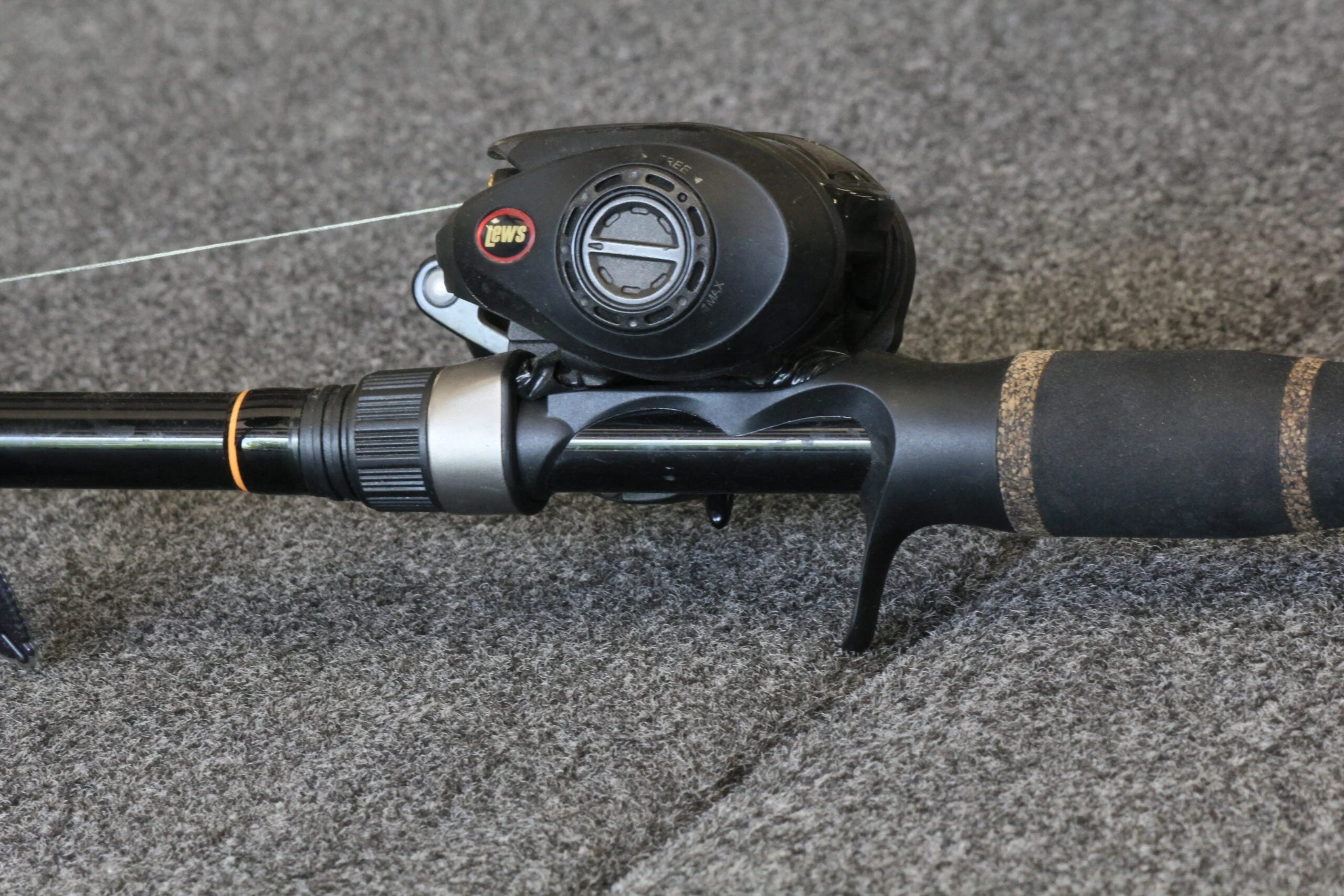
It’s best to adjust the braking system first and then really fine-tune things with the spool-tension knob. Most braking systems have some sort of indicator similar to More and Less. Many have a range from 0 to 6 or 1 to 10. Moving the dial toward More (or a higher number) applies more braking. It’s best to start here with your braking system a little above the midway point, then back off slightly as you get more comfortable.
How to Set the Spool Tension on a Baitcaster
The spool-tension knob is about the diameter of a dime, and, like the drag, it’s found on the handle side of the reel. The spool-tension knob has no real clear dial indicator. The more you roll it forward, the tighter the actual knob will get. This indicates that you’re applying more tension to the spool. Backing off of the knob will loosen it up and apply less tension. Though the setting of the dial is hard to gauge by the naked eye, there’s a simple trick to set the spool tension for each bait.
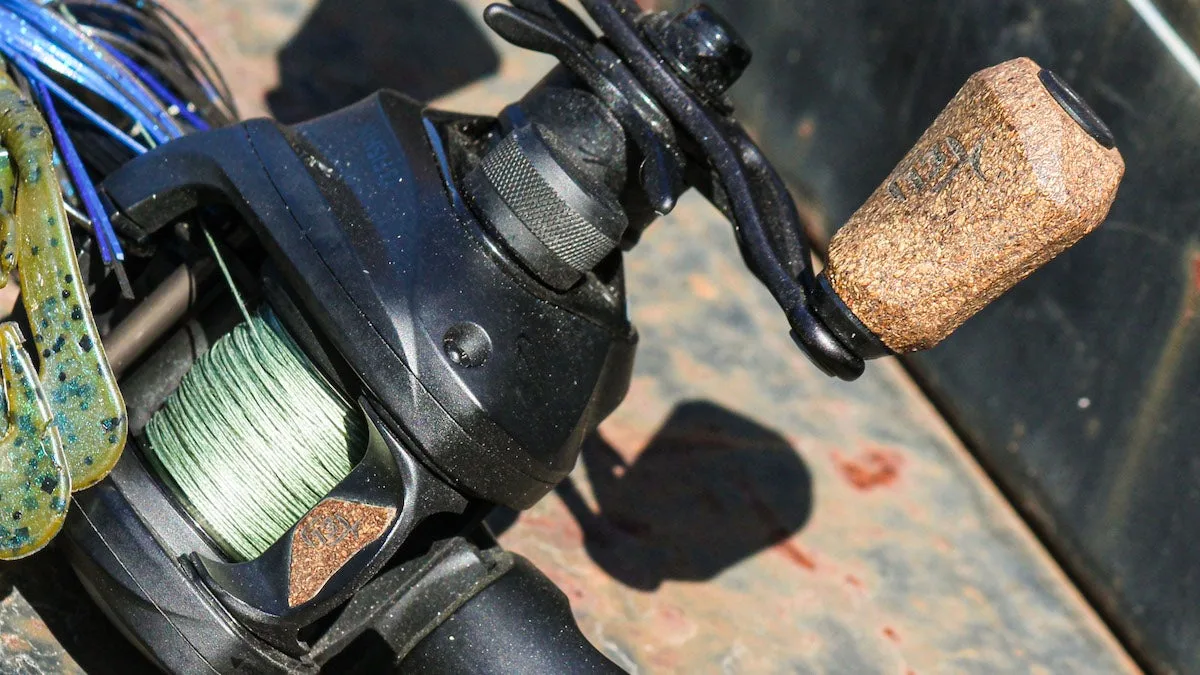
As mentioned above, tie on a lure and tighten your spool-tension knob until it’s snug. Hold your rod tip straight out in front of you with your rod parallel to the ground. Then click the spool release. Now you want to loosen the spool-tension knob slowly until the bait starts to fall to the ground under its own weight. This is where you’ll want your spool-tension knob once you get comfortable. But for now, tighten your spool-tension knob back up a quarter turn. Then turn your reel handle until your reel engages.
How to Make Perfect Casts With a Baitcaster
With the braking system and spool-tension knob set, you’re now ready to learn how to cast a baitcasater. Use your thumb to push down the spool-release (or thumb bar) on your reel, keeping your thumb on the spool to keep it from spinning. You’ll want about a foot of line between your bait and the rod tip. Now bring the rod tip behind your head and then bring it quickly forward while simultaneously raising your thumb slightly off the spool, but still feathering it just enough to keep it from overrunning.

Hopefully this results in your bait going out a decent distance in front of you, and not in a backlash. If your spool does overrun a little, carefully pull the backlash out, tighten your spool-tension knob a little and try again. With a little practice, you should be able to repeat this process until you get the hang of making casts without backlashing.
Once you start getting more comfortable, begin slowly backing off of the spool-tension knob to increase your casting distance. You can do the same with your braking system, but you will never really need to go below 40 percent here.
Mastering Thumb Pressure on a Baitcaster
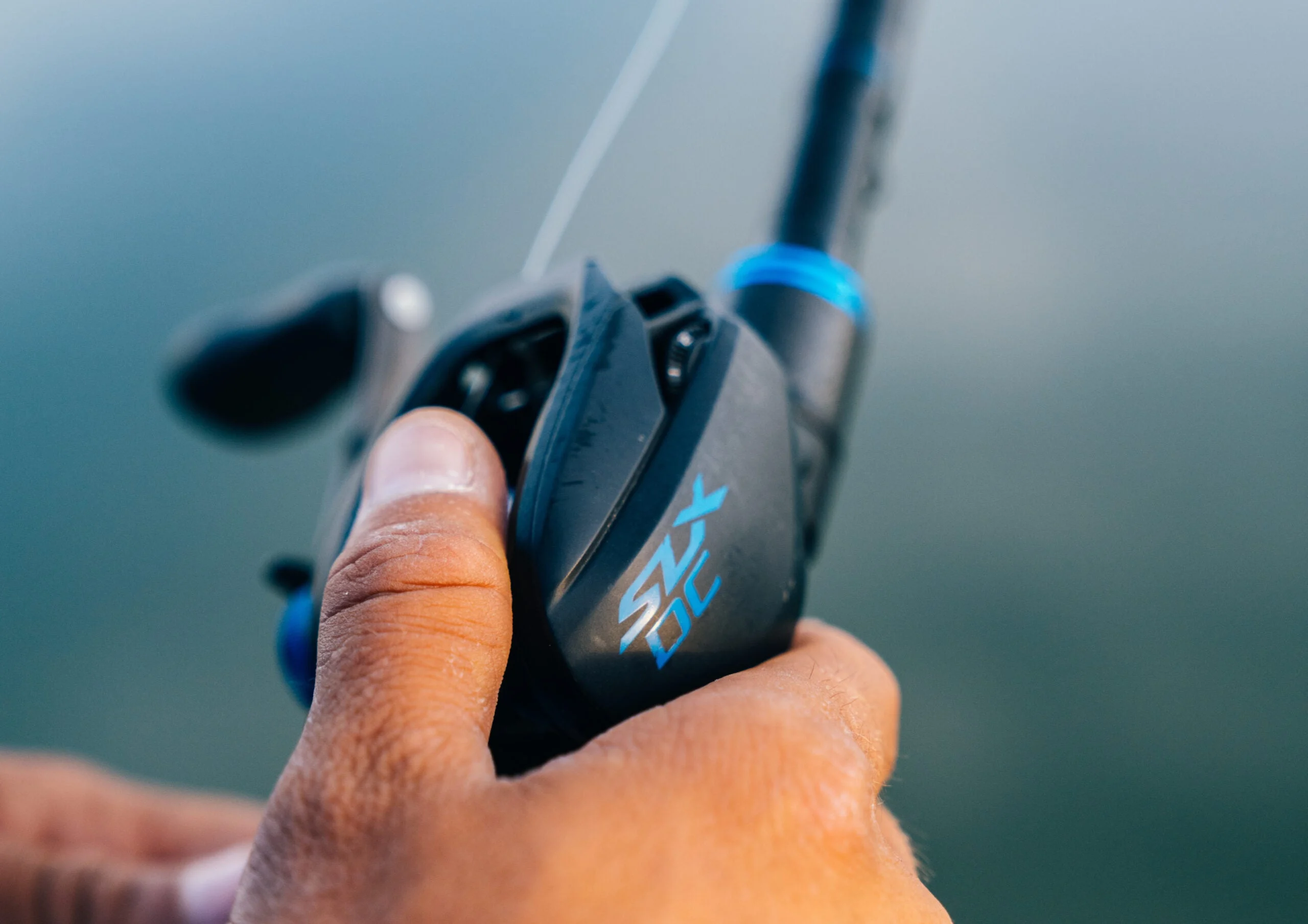
It’s important to understand that no matter how perfectly your baitcaster is adjusted, these reels never truly run on autopilot. Which, in a way, is what makes them more fun to use, like driving a stick instead of automatic. You’re always regulating how much thumb pressure you put on the spool during the cast. Let it skim the spool lightly to start, but if you need to slow down the rate that spool is spinning or are worried about a backlash on touchdown, you can manually control the spool speed with your thumb.
Ultimately, what you’re looking for is a perfect harmony between the spool-tension adjustment, the brake setting, and your thumb pressure. With practice, you can readjust your reel’s setting for anything you want to cast and determine if you need to add or subtract thumb pressure without even thinking about it. It’ll all become second nature, and pretty soon you’ll be casting a baitcaster like a pro.

